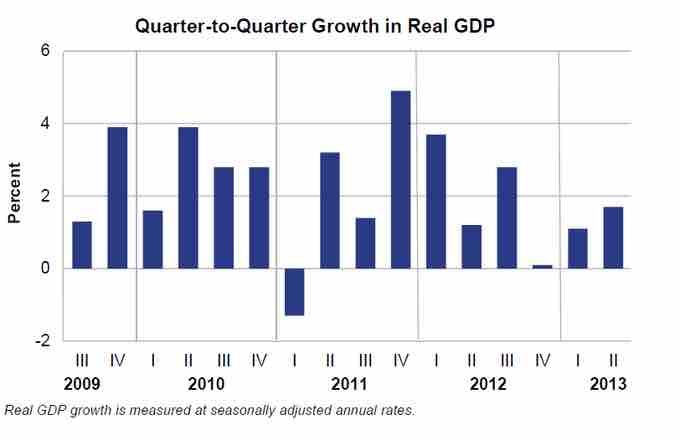Gross domestic product provides a measure of the productivity of an economy specific to the national borders of a country . It can be measured a few different ways and the most commonly used metric is the expenditure approach; however, the second most commonly used measure is the income approach. The income approach unlike the expenditure approach, which sums the spending on final goods and services across economic agents (consumers, businesses and the government), evaluates GDP from the perspective of the final income to economic participants. GDP calculated in this manner is sometimes referenced as "Gross Domestic Income" (GDI).

GDP over time
GDP is measured over consecutive periods to enable policymakers and economic agents to evaluate the state of the economy to set expectations and make decisions.
This method measures GDP by adding incomes that firms pay households for factors of production they hire- wages for labor, interest for capital, rent for land, and profits for entrepreneurship. The U.S. "National Income and Expenditure Accounts" divide incomes into five categories:
- Wages, salaries, and supplementary labor income
- Corporate profits
- Interest and miscellaneous investment income
- Farmers' income
- Income from non-farm unincorporated businesses
Two adjustments must be made to get the GDP: Indirect taxes minus subsidies are added to get from factor cost to market prices. Depreciation (or Capital Consumption Allowance) is added to get from net domestic product to gross domestic product.
Income Approach Formula
GDP = compensation of employees + gross operating surplus + gross mixed income + taxes less subsidies on production and imports. Alternatively, this can be expressed as:
GDP = COE + GOS + GMI + TP & M – SP & M
- Compensation of employees (COE) measures the total remuneration to employees for work done.
- Gross operating surplus (GOS) is the surplus due to owners of incorporated businesses.
- Gross mixed income (GMI) is the same measure as GOS, but for unincorporated businesses. This often includes most small businesses.
- TP & M is taxes on production and imports.
- SP&M is subsidies on production and imports.
The sum of COE, GOS, and GMI is called total factor income; it is the income of all of the factors of production in society. It measures the value of GDP at factor (basic) prices. The difference between basic prices and final prices (those used in the expenditure calculation) is the total taxes and subsidies that the government has levied or paid on that production. So, adding taxes less subsidies on production and imports converts GDP at factor cost (as noted, a net domestic product) to GDP.
By definition, the income approach to calculating GDP should be equatable to the expenditure approach (Y = C + I+ G + (X - M)). In practice, however, measurement errors will make the two figures slightly off when reported by national statistical agencies.